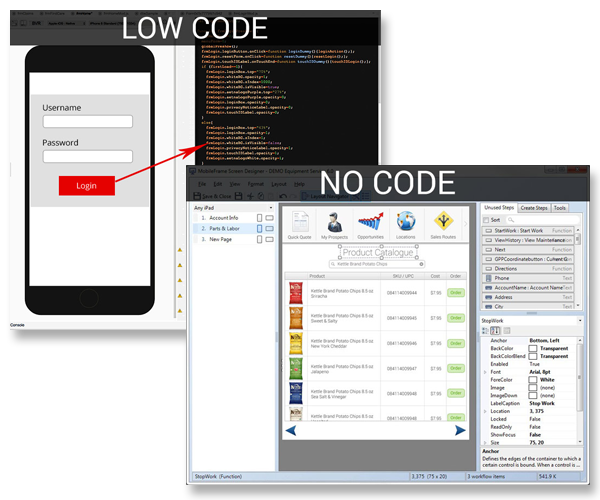Top Reasons On Deciding On Low-Code Platform Recommendations
Top Reasons On Deciding On Low-Code Platform Recommendations
Blog Article
Benefits Of Low-Code Application Development For Non-Developers
Due to a range of important factors, Low-Code Application Development is available to people who are not developers. These are known as "citizen designers."
Drag-and-Drop Builders : Low-code platforms offer drag-and–drop interfaces which enable people who are not developers, and without the need to write code, to build visually appealing applications. This allows development to be easier for people with technical background.
WYSIWYG Editors - "What You Seen Is What You Get" editors assist users in creating workflows or interfaces that look like the final products and make them more understandable.
Simple Workflow and Logic Design:
Visual Workflow Design: Users can quickly design business processes and application logic with flowcharts, models and diagrams. They are simpler to work with than traditional coding.
Low-code platforms are often equipped with pre-built logic components (e.g., conditions loops, statements), which reduce the need for complicated coding.
Reusable Components and Templates
Libraries of pre-built templates: Numerous low-code platforms have templates for the most common types of applications that allow non-programmers to begin with a solid foundation and modify as they need to.
Reusable Widgets and Modules: Users can use reused widgets. This allows for a simpler creation and helps to reduce the need for extensive understanding.
Tutorials for Guided Development and Guided Development
Step-by-step guides Platforms provide tutorials, on-screen tips, and guided development paths to assist developers who are not experts in developing applications.
Interactive Tutorials Interactive tutorials are hands-on and interactive that allow users to learn by doing. This boosts their confidence in the platform.
Integration with Tools Already in Use
seamless integration: Low-code platform are designed to seamlessly integrate with the existing business tools, systems, as well as software (e.g., ERP and CRM, ERP). This enables non-developers who do not have a prior experience in programming to design applications that work with their current workflows.
APIs and Connectors: Built-in APIs and connectors simplify the integration process, enabling non-developers to connect their applications to external services without the need for the need for complicated programming.
Collaboration Features:
Team Collaboration Features, like real-time collaboration and shared workspaces, allow professionals and non-developers to work together effectively.
Access Control based on Role: Users who are not developers can be assigned roles with the appropriate access levels. This allows them to contribute to development without compromising security or functionality.
Automated Debugging, Testing and Debugging
Test Tools Included: A lot of low-code platforms come with integrated debugging and testing tools. These tools automatize the process, making it easy for non-developers ensure that their applications are operating properly.
Error Highlighting: When issues arise the platform flags the errors and suggests solutions, guiding non-developers through troubleshooting procedures.
Low-code development is easier for non-developers to access because it allows for democratization of the development process. Low-code applications allow business users to participate actively in the creation and maintenance of applications through the use of intuitive visual tools as well as a guiding experience. This is a bridge between technical implementation and business needs. Read the most popular weblink about Low-code Platform for application development for site examples including build with docker, azure sql, developing mobile apps, cross platform mobile development, build a docker container, cross platform app dev, cross platform mobile development, develop web app, ms azure sql, driver jdbc and more.
Cost-Effectiveness Is One Of Many Advantages Of Developing Apps With Low-Code.
Low-code application development offers numerous benefits in terms of cost-efficiency and efficiency, which makes it an appealing option for businesses looking to reduce their development costs while still delivering top-quality software. The main advantages:
Less Coding Needed: Low-code platform reduces the need for lengthy manual coding. This means less time and effort on the part of developers while developing their applications. This means lower cost of labor.
Reduced Developer Resources: Since low-code is quicker and easier to create, less skilled developers will be needed. It could reduce the costs of staffing and hiring.
Faster time to market
Accelerated cycle of development: Visual tools for development as well as pre-built parts provided by platforms with low-code enable rapid design of applications, which allows companies to get their products on the market more quickly. This will result in faster revenue generation and better competitive positioning.
Rapid prototyping: By developing and testing prototypes quickly, businesses can reduce the time they spend in the process of development and also allow for faster iterations on the basis of user feedback.
Lower Maintenance Costs
Simple Maintenance: Applications developed using low-code platforms are generally simpler to maintain because of their standardized components and modular architecture. Maintenance and support costs are cut.
Automated Updates: A lot of low-code software platforms manage patches and updates automatically making sure that applications remain safe and up-to-date without requiring extensive manual intervention.
Efficient Resource Utilization:
Low-code platforms enable people who are not developers to take part in the development process. This empowers businesses to utilize the talents of many employees, and lessen their dependency on highly-paid programmers.
Optimized IT Resource Use IT departments will be able concentrate on strategic initiatives, rather than being buried in routine development tasks. This will increase the overall efficiency and productivity.
Scalable Pricing Models:
Subscription pricing: A lot of low-code platforms provide flexible subscription pricing models which can be scaled according to usage. This enables businesses to make sure that their budget is in line with their needs and grow.
Pay-as-you go options Certain platforms offer pay-as-you-go options, ensuring that companies only pay for the resources they utilize, which can be particularly useful for small and new companies with a limited budget.
Reduced Third-Party Software costs:
Built-in Functionalities: Low-code systems often come with built-in functionalities and integrations that reduce the need for additional third-party tools and software, which results in savings on licensing fees and subscription fees.
Pre-Built Integrations: The availability of pre-built integrations for popular platforms and services eliminates the need for custom development, thereby saving time and money.
Increased ROI
Improved ROI: Businesses can get a better return on investment from applications that combine rapid development, lower costs and speedier time to market.
Improved agility: Companies can adjust quickly to changes in the market or to customer demands which enables businesses to stay relevant and benefit from new opportunities.
Low-cost Training:
User-Friendly Interfaces: Low-code platforms provide intuitive and simple-to-use interfaces, which reduces the learning curve.
Accessible Resources: Many low-code platforms offer comprehensive instructional materials, tutorials as well as community support, cutting the requirement for formal education and the associated expenses.
Collaboration can be made easier.
Enhanced collaboration tools: The integration of collaboration tools allows for more effective collaboration between team members, as well as an improvement in overhead for projects.
Unified Development Environment: A single integrated development environment helps simplify workflows and decreases the cost and complexity of managing multiple tools and platforms.
In general, low-code apps are cost-effective due to their ability to reduce costs for development and maintenance, to accelerate time-to-market, to optimize the use of resources and also to offer flexibility in pricing. These elements provide huge financial rewards to businesses. Low-code development is an excellent option for businesses that want to maximize budgets but still create robust, scalable and quality software. Read the best Enterprise application development with Low-code Platform recommendations for website recommendations including cross platform mobile development, database in azure, build with docker, cross platform app dev, rad development, driver jdbc, application modernization, build a docker container, application development platforms, develop cross platform mobile app and more.
Low-Code App Development Has Many Advantages In Terms Collaboration And Workflow
It's a great option for companies that wish to increase team productivity as well as streamline processes and enhance collaboration. These are the main benefits: Improved Collaboration Across Functions:
Unified Development Environment. Low-code platforms let all team members collaborate in a single, unifying environment. This includes business analysts, developers, designers, and stakeholder. This eliminates barriers and improve communication.
Visual Development Tool: The drag and drop nature of platforms that utilize low-code makes it easier for team members who aren't technologically inclined to participate in the development process. They can assure that business needs are accurately analyzed and implemented.
Advanced Communication
Real-Time Collaboration Many low-code applications offer real-time capabilities, like commenting and editing simultaneously, or instant feedback. This allows for continuous communication, and helps reduce the amount of time spent in a back and forth discussion.
Workspaces shared by teams. Teams can collaborate through shared workspaces. Here, they can review, edit, and discuss various project components.
Workflow management streamlined:
Built-in Project Management Tools : Low-code platforms typically contain integrated software for managing projects that help teams organize, track, and manage, and coordinate their projects for development. This includes assignment of tasks, tracking progress, deadline management and more.
Workflow automation: The automation of repetitive tasks, workflows, as well as other processes decreases the manual effort needed and reduces the chance of making mistakes. This allows teams to focus on higher-value activities and boosts efficiency.
More Rapid Iteration:
Rapid prototyping: Low code platforms permit rapid prototyping, iterative development and quick prototyping. This allows teams to develop applications that are tested, then refine them in shorter cycles. This allows feedback to be rapidly incorporated, and improvements can be made.
Agile Development Support The support for agile methodology lets teams work in sprints, continuously providing small amounts of functionality and making it easier to adapt to changing requirements.
Accessibility for Non-Developers
Citizen Development: Low-code platforms allow business users the ability to design and edit apps with no coding experience. This lets IT and development teams to concentrate on other projects and be more responsive to business demands.
Training and Onboarding - Simple interfaces, comprehensive training materials, and intuitive interfaces make it easier for new team members to get familiar with the system and boost the overall team collaboration.
Centralized Documentation, Knowledge Sharing and Information Sharing
Low-code platforms usually have the ability to create, maintain and storing documentation on their platforms. This allows the entire project's information to be stored in a central location and easily accessible.
Knowledge Repositories Teams can build and maintain repositories of information that include best practice templates, templates, and other reusable elements, facilitating sharing of knowledge and reducing duplicate work.
Consistency & Standardization
Standardized Components. The commonality of components across various applications ensures consistency, which helps to make it easier to work and be understood the team members.
Governance and Compliance: Built into governance frameworks that ensure that every development adheres to the standards of the organization and regulatory needs, reducing the risk of non-compliance while ensuring that applications meet high quality standards.
Feedback and Improvement:
Integrated Feedback mechanisms: Low-code platform usually have an integrated feedback mechanism, which allows users to provide feedback on applications. Feedback can then become integrated into the development.
Continuous Improvement: The capacity to quickly test and deploy modifications as a result of feedback ensures constant improvement of software. They are closely aligned to the requirements of users as well as business objectives.
Visualization of Reporting
Real-Time Analyses: The built-in reports and analytics tools provide immediate insight into project's performance, progress and user interactions, making it possible to make data-driven choices.
Visual Workflow mapping: Visual tools that map workflows can be used by teams to enhance workflows. This allows them to identify the bottlenecks, as well as areas of improvement.
Overall, the advantages of low-code development in terms of workflow and collaboration lie in its ability to bring together diverse teams as well as streamline communication and automate processes. This creates a collaborative, agile, and efficient development environment that leads to more efficient and high-quality applications.